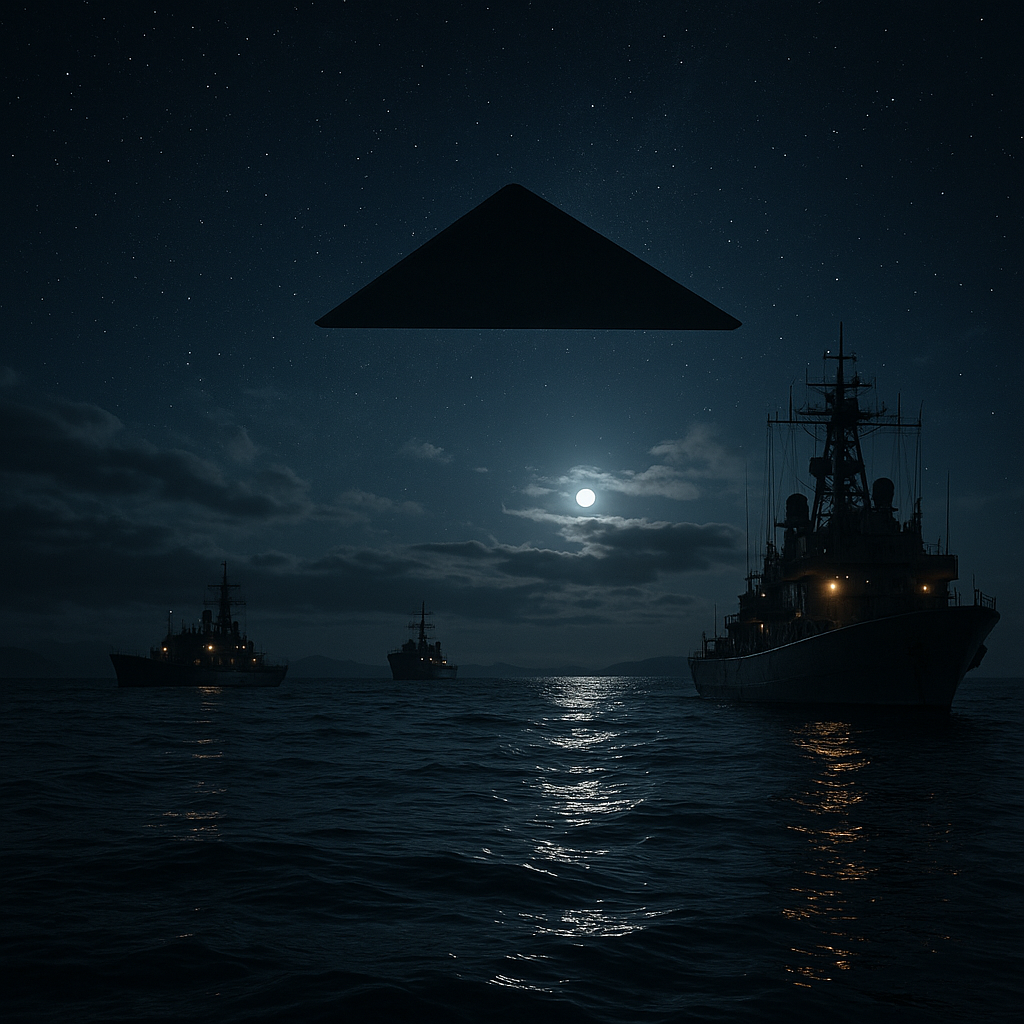UFO Whistleblower Goes Public: Pentagon Intelligence Insider Exposes Immaculate Constellation Program

Matthew Brown, a former intelligence contractor in the Pentagon’s Weapons of Mass Destruction (WMD) division with Top Secret/SCI clearance, discovered something unexpected during routine file work—what became known as the ‘Immaculate Constellation’ program.
In a landmark interview featured on Weaponized (Episode #74), hosted by Jeremy Corbell and George Knapp, a new whistleblower has stepped into the spotlight—Matthew Brown, former intelligence officer and author of the now-infamous “Immaculate Constellation” report. Submitted into the Congressional Record in November 2024, this document sheds light on what Brown claims is a deeply hidden U.S. government reconnaissance program dedicated to tracking advanced craft of both human and non-human origin.
According to Brown, the Immaculate Constellation program is not just another black budget military operation. He describes it as a full-spectrum reconnaissance initiative targeting unidentified aerial phenomena (UAP). Among the most shocking claims, U.S. Air Force F-22 jets were allegedly “boxed in” by fast-moving orbs they couldn’t outmaneuver. Satellite imagery exists of a football field-sized flying saucer concealed in cloud cover. Brown affirms: “I can confirm this 100%.”
Brown argues that the issue isn’t just the technology—it’s the moral and existential cost of secrecy. He says that maintaining classified status on these phenomena has been used to intimidate, threaten, and even ruin the lives of individuals trying to tell the truth. The secrecy apparatus, in his words, is “all-pervasive” and “infests every aspect of our society.”
“This isn’t just something someone came up with in a lab… The answer to whether we are alone is no.”
He emphasizes that this secrecy is robbing humanity of its right to know who we are, what is here with us, and what our potential future could be.
After years within the intelligence community and the Pentagon, Brown reveals that he has decided to come forward despite enormous risks—including life imprisonment or even execution—for disclosing classified information. He insists that the global situation is deteriorating rapidly, and humanity is being imprisoned by fear and misinformation.
“We are not headed to a good future… There’s still time to alter our trajectory.”
His choice to speak is, according to him, a last resort after exhausting all official channels. The implication? There is no remaining internal mechanism for ethical transparency.
Brown suggests that control of UAP technology is now fragmented, with significant influence held by international corporations and private interests that operate beyond the boundaries of any one nation. He warns this is not merely about profit or power—there is a deeper fear behind the coverup.
“It’s above just monetary gain and power. They’re afraid.”
He calls it a “parallel reality”—a shadow governance where the interests of an elite few outweigh the rights and safety of the public.
In his Pentagon work under the WMD (Weapons of Mass Destruction) umbrella, Brown held a Top Secret Sensitive Compartmented Information (SCI) clearance. He worked with intelligence flowing in from multiple platforms, giving him exposure to a massive, layered apparatus—one that already seemed like a “different world” even before factoring in exotic phenomena. He noted that much of the most profound knowledge is not written down, but shared through lived experience in the intelligence community. Brown described the role as burdensome, even noble, and admitted the information he encountered—on nuclear weapons, black market transfers, and biological threats—was sometimes haunting.
He characterized the national security structure as composed of “many worlds, many shells to our reality”—most of which remain hidden from the public, the press, academia, and even elected leaders. Many of those who do suspect the truth, he suggested, are often willfully misinformed.
While he wasn’t a field officer or clandestine agent, Brown was responsible for interpreting all-source intelligence, including human and signals intelligence. He confirmed that certain incidents he came across caused serious personal alarm, though he declined to specify them. He spent over four years in Pentagon service and moved to a role within the Office of the Under Secretary of Defense for Intelligence. Like many, he served as a contractor—standard practice in D.C.—with daily oversight from government managers, although he admitted that oversight quality varies.
Brown explained that while he had a long-standing interest in UFOs and secret history, he was not a true believer or “UFO guy.” By the time he began work at the Pentagon, he’d largely dismissed the idea that extraterrestrials were visiting Earth. Instead, he believed most sightings were likely advanced technologies—ours or an adversary’s. Over time, however, exposure to deeper layers of information would challenge and overturn those assumptions.
He clarified that his discovery of UAP-related materials—including what became known as the “Immaculate Constellation”—was entirely accidental. His research habits, driven by curiosity and a dedication to understanding systems thoroughly, led him to stumble upon these materials while working late at the Pentagon. His access to JWICS, the classified intranet for intelligence professionals, provided him with video footage and data logs that revealed anomalous aerial objects. Some videos were 15 seconds of crystal clarity, others blurry but lengthy. Most lacked traditional propulsion or flight control surfaces and were seen around nuclear sites.
JWICS, or the Joint Worldwide Intelligence Communications System, is a secure top-secret-level intranet operated by the U.S. Department of Defense and the intelligence community to handle classified information. While Matthew Brown briefly mentioned JWICS in his interview, the system was already publicly known prior to his disclosures. It gained broader attention through earlier leaks, including those by Chelsea Manning and Jack Teixeira, which exposed the types of sensitive data it transmits. While primarily U.S.-controlled, Five Eyes allies like Canada, the UK, and Australia may have limited or indirect access through joint operations—but JWICS itself remains strictly under U.S. control and is not independently operated by foreign partners.
Brown says that many nuclear facilities seem to attract unidentified aerial visitors—often small orb-like craft, silver or white, appearing hot or cold depending on sensor mode. While not overtly dramatic, the frequency and placement of these sightings suggest a persistent pattern. His growing curiosity, sparked by such content, led to more questions, but little open discussion. Within the intelligence community, Brown says, it was tacitly understood: “We don’t talk about this.”
By 2017, the conversation began to crack open, but soon after, restrictions were reimposed. Whistleblower names like David Grusch reportedly became taboo in some agencies. Brown recounts hearing that even mentioning Grusch’s name could jeopardize careers. He recalls classified chatrooms turning hostile toward anyone speaking positively about Grusch, with internal clamping down following what he suspects was a counterintelligence prerogative. What initially felt like an open window of dialogue post-2017 was quickly shut down.
The turning point came in 2018, when Brown accidentally came across a file labeled as a war game briefing—”2018 Schriever War Game”—while performing a routine document cleanup. One slide bore the title “Immaculate Constellation” and unexpectedly featured Lou Elizondo’s image and a description naming the program as an unacknowledged SAP created after the ATIP revelations. The document was improperly marked and lacked classification labeling, but Brown instantly recognized the implications. He read on.
The next slides revealed a surveillance operation over the Pacific, showing Russian naval intelligence ships being observed by a large black triangular craft hovering silently just 200 meters above them. The imagery appeared to come from a clandestine submersible asset. The Russian ships reportedly did not react, and analysis suggested they had foreknowledge of the triangle’s appearance—possibly to observe or interact with it.
The document referred to the object as either an RV or ARV (reverse-engineered or alien reproduction vehicle), and described Immaculate Constellation’s broader mission as global ISR (intelligence, surveillance, reconnaissance) on UAPs. Later slides in the briefing displayed orb sightings from around the globe, suggesting a centralized repository of UAP data. The document was roughly 12–15 pages long.
Brown confirmed it was the only document he’d ever seen that explicitly used the term “Immaculate Constellation”—until he wrote his own.
He also discussed transcripts he reviewed while in USDI, including classified briefings from Sean Kirkpatrick to senators like Rubio, Gillibrand, and Warren. These discussed the “legacy program” and implied a longstanding unauthorized project run outside of congressional oversight. Brown recalls Rubio asking in disbelief whether the executive branch had been operating this program for 60 years without disclosure. That moment, he says, made his blood run cold.
“There really isn’t room for people to act according to their conscience on the inside.”
Matthew Brown’s testimony may well mark a turning point in the public conversation around UAPs. As part one of a three-part series, it opens the door to even deeper disclosures in the weeks ahead. With mounting documentation, whistleblower bravery, and escalating public interest, the days of secrecy surrounding non-human intelligence may be numbered.

